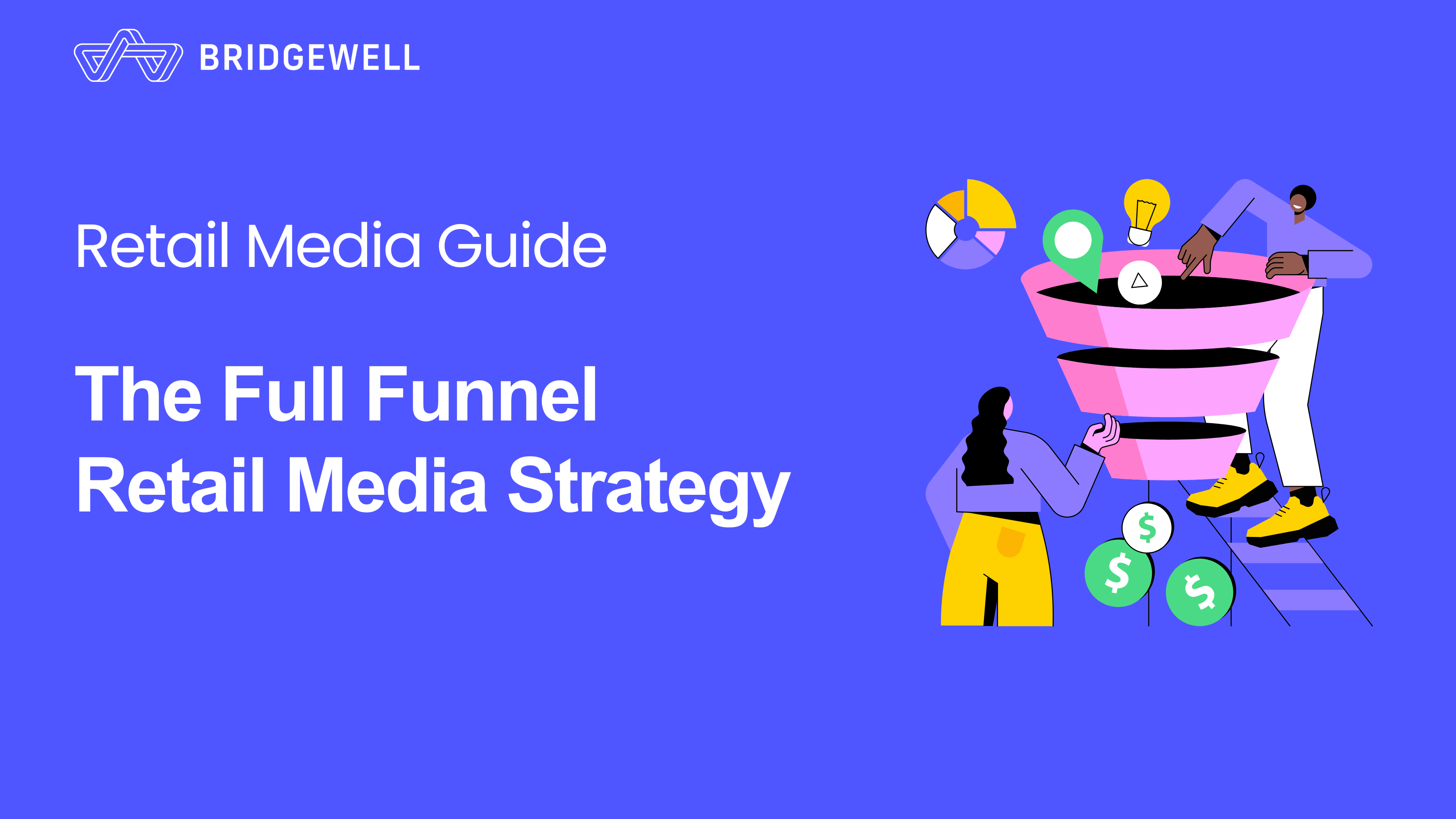Achieving success with a full-funnel retail media strategy requires more than simply optimizing for specific metrics. A true full-funnel strategy demands a measurement approach that comprehensively captures the consumer journey—from initial brand awareness to post-purchase loyalty building – ensuring no stage is overlooked.
Evolving Your Marketing Funnel:
the Full Funnel Strategy for Retail Media
Today’s consumers can enter and exit the shopping journey at any point, making it increasingly difficult for traditional marketing approaches to keep pace in channels like retail media. Full-funnel retail media has become a hot topic because it is seen as a more adaptable solution to this new market reality. However, clear and actionable guidelines on how to implement it effectively remain scarce.
In this content, you’ll discover a well-defined and actionable framework for full-funnel retail media. This framework is designed to effectively engage consumers at every touchpoint, guiding them seamlessly from one stage to the next until the conversion goal is achieved.
The winning formula for full-funnel retail media
In recent years, as digital commerce has advanced, more brands have integrated retail media into their omnichannel strategies. Each year brings refinements to their approaches, experimentation with new ad formats, testing of placements, and efforts to maximize the effectiveness of every retail media platform.
The results have been promising, with growing expertise in ad formats, placement strategies, and media network usage. However, as competition intensifies and consumers increasingly switch between online and offline channels, upgrading strategies has become imperative.
The “Full-Funnel Approach” has long been considered the best solution, enabling effective engagement at every stage of the consumer journey. Yet, it has often lacked clear implementation guidance. Many experts hail it as the ultimate strategy but rarely provide actionable steps. This article introduces the Full-Funnel Retail Media Formula—a clearly defined, structured, and practical approach that organizes scattered concepts into a cohesive, actionable strategy.
A full-funnel approach isn’t just about having a presence at each stage—it’s about knowing when, how, and where to use retail media tools for maximum impact. By executing with precision, each interaction with the consumer helps move them closer to purchase conversion while building brand loyalty. Whether it’s using targeted sponsored ads to reach new audiences or leveraging in-store advertising to drive purchases, the Full-Funnel Retail Media Formula helps dynamically adjust strategies with measurable results.
This article offers practical advice and real-world examples to demonstrate how to apply the full-funnel approach for various needs. It’s not a rigid playbook but a flexible guide to help plan and optimize strategies more effectively. The insights from the Full-Funnel Retail Media Formula will be a critical tool for staying competitive and achieving marketing goals.
–
1. Evolve your marketing funnel
The concept of the marketing funnel has been around for a long time, leading some marketers to believe that this framework is outdated and less relevant in today’s digital and omnichannel marketing landscape. However, this framework remains highly valuable as it addresses a common and challenging question: “How can we deeply understand a diverse group of consumers and design marketing strategies that effectively reach them?”
The marketing funnel continues to be effective because every brand’s audience can generally be divided into three categories:
- Consumers who have never heard of your brand or know very little about it.
- Consumers actively seeking products or solutions that your brand might offer.
- Consumers who are engaged and ready to make a purchase.
These three audience groups align well with the traditional marketing funnel structure. While the model may seem outdated to some, it remains highly useful for understanding a brand’s audience segmentation. That said, the marketing environment has evolved, and the funnel design must adapt accordingly.
In the new full-funnel approach, it’s essential to redefine the roles of each funnel stage and integrate the precise capabilities of retail media to optimize the journey.
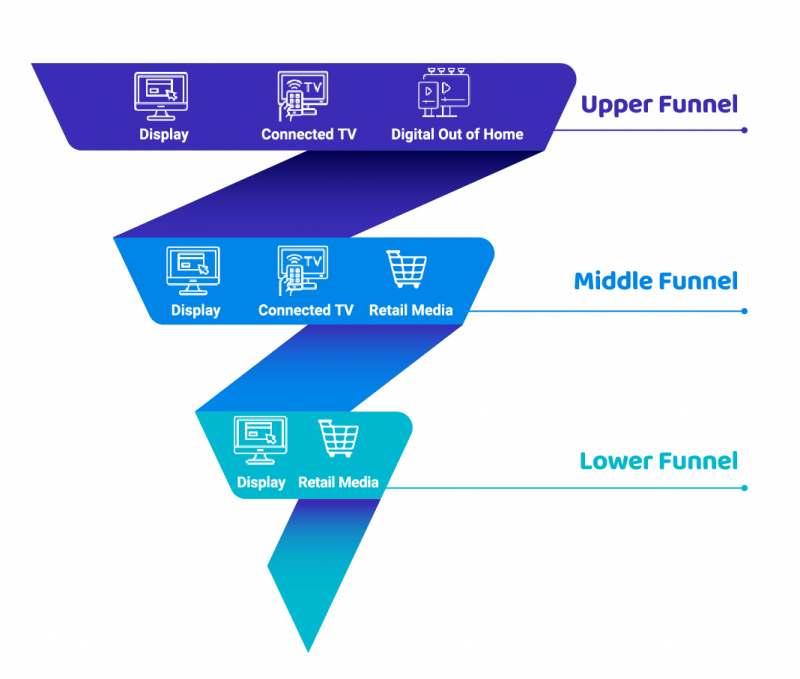
–
Top-of-the-funnel (TOFU)
Traditionally, the top of the funnel focuses on building broad brand awareness using a “casting a wide net” approach to reach as many people as possible. However, this overly general method needs to evolve into a strategy that leverages retail media for scaled, precise targeting. This allows brands to not only increase awareness but also maximize their reach in a meaningful way.
By using data and advanced targeting technologies, retail media ensures that campaigns reach the right audiences at the right time, fostering more impactful and relevant interactions.
Middle-of-the-funnel (MOFU)
Traditionally, the middle of the funnel aims to nurture consumer consideration, ensuring the brand remains visible as customers evaluate their options. Modern strategies, however, need to go further by actively shaping the consumer’s decision-making criteria.
This involves leveraging personalized messaging, dynamic ads, and intelligent targeting to influence the decision process, positioning your brand as the optimal solution. The goal is to ensure that when consumers make their final purchase decision, they naturally choose your product—even without realizing their choice has been subtly guided.
Bottom-of-the-funnel (BOFU)
Consumers at the bottom of the funnel are typically the most valuable, warranting greater ad budget allocation as they are closest to making a purchase. However, broad discounts or generic promotions alone are not enough to close the deal. At this stage, brands need to act like skilled salespeople, adapting to individual needs with precision.
Retail media’s robust data segmentation capabilities enable highly targeted, tailored offers. For example, instead of treating all price-sensitive shoppers as one group, you can break them down into subcategories such as frequent bargain hunters, loyal value-driven customers, or first-time price-sensitive buyers. Each segment can then receive customized strategies designed to close the deal seamlessly.
Traditional marketing methods vs. full-funnel retail media
The table below highlights the limitations of traditional retail media strategies and demonstrates how the Full-Funnel Retail Media Formula redefines each aspect of modern, dynamic marketing practices.
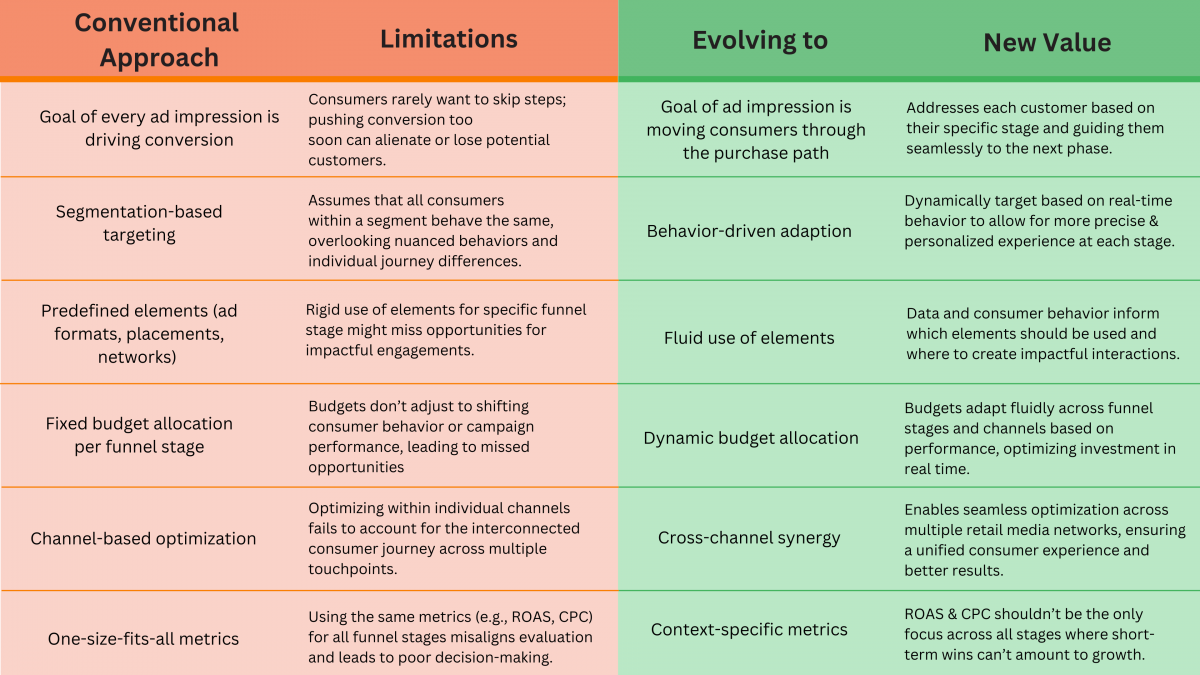
–
A new retail marketing funnel designed for modern consumers
The Full-Funnel Retail Media Formula reimagines the marketing funnel to address the complexities of today’s consumer journey. It enables brands to break free from rigid, one-size-fits-all strategies and adopt a more flexible approach that dynamically adjusts based on consumer behavior.
By evolving from traditional broad segmentation and static strategies to precision targeting and behavior-driven holistic tactics, the full-funnel retail media approach ensures meaningful engagement with potential customers at every stage of their journey. It guides them seamlessly from brand and product discovery to the point of conversion.
This flexibility also means that elements once considered exclusive to a specific funnel stage can now be applied more broadly. For example:
- Precision targeting, historically reserved for the bottom of the funnel, can now be utilized in earlier stages. By leveraging detailed audience behavior analysis, brands can “cast a smarter net” to create stronger brand impressions more effectively.
- Front-end strategies, such as video ads that enhance brand image, can also be employed closer to the point of sale to boost consumer affinity for the product.
This framework allows for a more cohesive, data-driven retail media strategy, maximizing the impact of advertising and marketing efforts at every stage of the funnel. The result is a significant boost in overall brand value and return on investment.
–
2. Applying full-funnel advertising formats
In today’s retail media landscape, the true strength of advertising formats lies not just in their versatility but in how strategically they are deployed to guide consumers smoothly from one end of the funnel to the other. The Full-Funnel Retail Media Formula redefines our understanding of advertising formats. Instead of being confined to a specific funnel stage, ad formats are now used dynamically, in context-driven ways, to engage and influence consumers throughout their journey.
Over time, certain combinations have proven particularly effective—for instance, video ads excel at driving awareness at the top of the funnel. However, the essence of a full-funnel strategy is to break free from rigid preconceptions of where specific formats “should” be used. Instead, it focuses on how, when, and where to use each format to deliver the right message to the right audience at the right time.
Sponsored ads
Sponsored ads are often utilized within search results or product pages to highlight products and reinforce brand identity. Seamlessly integrated into the shopping experience, these ads are particularly valuable for driving bottom-of-the-funnel conversions as they appear at critical decision-making points, such as product pages. Combined with brand-specific targeting, sponsored ads typically have a significant impact on conversion rates.
However, sponsored ads can also play a powerful role in the middle of the funnel (MOFU), especially when leveraging in-market audiences, competitive brand targeting, or consumer behavior-based segmentation. By excluding past purchasers, brands can focus on converting new customers, further driving overall revenue growth.
Surprisingly, sponsored ads can even be an effective tool for top-of-the-funnel (TOFU) brand exposure. By leveraging retail platform trends and behavioral insights, audiences can be segmented based on their journey stage, enhancing brand awareness and affinity. This early engagement lays the groundwork for more effective conversions later in the funnel.
Display ads
Display ads are renowned for their visual appeal and versatility, effectively capturing attention and keeping the brand top of mind as consumers browse online. The impact of display ads often depends more on audience targeting than the format itself. For example, display ads can be tailored to meet the needs of audiences at different stages of the buying journey. Additionally, because they are relatively easy and quick to produce, display ads are well-suited for use at every stage of the funnel.
On-Site Display Ads
These are placed directly on the retailer’s platform, making them highly effective for driving conversions due to their proximity to the point of purchase and strong alignment with consumer intent.
Off-Site Display Ads
Off-site ads are ideal for building brand awareness and expanding the reach to potential new customers. By leveraging contextual and scenario-based targeting, these ads can engage consumers on their favorite websites or content platforms, creating a positive brand impression. Ultimately, they guide consumers back to the retailer’s site, encouraging them to explore more products, add items to their cart, or even complete a purchase.
Video ads
Video ads, including digital video, streaming media, and connected TV, have rapidly emerged as one of the fastest-growing digital ad formats in recent years. They are versatile and can be utilized effectively at any stage of the funnel.
The key features and advantages of video ads include immersive visual experiences, sound, and dynamic effects. These elements enable brands to tell stories vividly, showcase product benefits, and establish emotional connections with audiences. Video ads are particularly impactful for launching new products or brands, helping to build market share and drive revenue growth.
–
DSP Dynamic Ads
Dynamic ads delivered through demand-side platforms (DSPs) are tailored in real-time based on consumer behavior and product demand, providing personalized content that meets individual needs.
On-site placement
Dynamic ads can engage diverse audience segments within the retailer’s ecosystem, ensuring that the right message reaches the right consumer at the perfect moment.
Off-site placement
When deployed off-site, dynamic ads leverage the vast reach of external audiences, expanding visibility while maintaining relevance to potential consumers.
The unique value of dynamic ads lies in their ability to adjust in real-time based on consumer interactions. This creates a personalized shopping experience that resonates more closely with audiences and delivers messages at the most opportune moments.
Engaging consumers at every funnel stage
In retail media, the variety of ad formats allows marketers to effectively engage consumers at any stage of the funnel. Each format offers unique advantages that, when used strategically, can maximize the ability to meet consumers’ specific needs at different points in their shopping journey.
The key is not to limit any format to a specific funnel stage but to understand how the characteristics of each format can influence and guide consumers forward at every stage.
–
3. Full-funnel retail media ad placement strategy
In the Full-Funnel Retail Media Formula, ad placements are no longer static touchpoints but pivotal levers that drive consumers along their shopping journey. Whether on-site, off-site, in physical stores, or on connected TV/streaming platforms (CTV), these placements act as real-time connectors between a brand and consumer purchase intent.
To achieve optimal results, it’s recommended to first select the placement and then choose the appropriate ad format. Placement determines when and where brand messages reach consumers, but it’s true value lies in its flexibility to adapt to the consumer’s shopping journey. This formula emphasizes contextual adaptability, leveraging real-time data insights and the consumer’s current position to deploy resources effectively and maximize impact.
As retail media continues to evolve, mastering the use of placements across diverse contexts has become a critical factor for success. Whether consumers are browsing an e-commerce platform, scrolling through social media, or walking through the aisles of a physical store, this formula ensures that brands connect with them at moments of peak focus and actionability.
On-site placement
The foundation of retail media success
On-site placement is at the core of most retail media strategies. Integrated directly into a retailer’s online store and mobile apps, it effectively reaches consumers who already have shopping intent. Common on-site ad placements include:
- Search Results Pages
- Homepage Banners
- Product Detail Pages (PDPs)
- Recommendation Widgets
- Category Pages
- Search Grid Placements
These placements are intuitive and convenient, making them familiar and easy to manage for marketers. However, this familiarity can sometimes lead to a lack of strategic depth. Many marketers follow standard practices without fully exploring the potential of on-site placements across different stages of the funnel.
In reality, the value of on-site placements cannot be overstated—they are the “prime real estate” of retail media, critical for consolidating and expanding market share. To maintain a competitive edge, marketers should adopt more aggressive budgeting and bidding strategies for these placements.
When used strategically, on-site placements can play a powerful role at every stage of the brand journey: from building brand awareness to capturing consumer interest and driving purchase conversions. It’s also worth noting that retail websites are not only conversion points but also the starting point for consumers to explore products. Ultimately, the purchase itself may even happen off-site.
Off-site placement
Extending influence beyond retailer platforms
Off-site placements allow retail media strategies to expand their reach beyond the retailer’s owned platforms, tapping into traditionally separate channels such as:
- Display Network Ads
- Social Commerce Ads
- Paid Search Ads
Display ad network: expanding brand reach potential
Display ad networks offer vast ad inventory and significant growth opportunities. Marketers can leverage retailers’ first-party data to create precise audience targeting, such as segmenting consumers into groups like “shelf browsers” or “product page visitors.” These data signals ensure that ads reach consumers while they browse their favorite content on blogs, news sites, or entertainment platforms, keeping the brand consistently within their view.
Contextual targeting for greater relevance
Through contextual targeting, ads can appear alongside relevant content, such as:
- Electronics ads placed on tech websites
- Beauty product ads featured on beauty blogs
- Outdoor gear ads displayed on hiking websites
Integrating channels to maximize overall strategy
Retail media blurs the traditional boundaries between channels, seamlessly incorporating off-site channels into a unified strategy. Social commerce and paid search ads, which once operated independently, now play a vital role in driving the consumer journey.
Marketers should balance the use of open web inventory with high-quality placements, building an ideal publisher list to ensure the brand appears on platforms where target audiences are most active. Additionally, securing premium ad placements through PMP (Private Marketplace) agreements can enhance the impact of campaigns.
In-Store Digital Ad Placement
Bridging the physical and digital worlds
In-store digital ad placements bring the flexibility of digital advertising into physical retail environments, making it an emerging area within retail media. Common formats for in-store digital ads include:
- Digital Signage
- Digital Shelf Talkers
- Digital Checkout Counter Displays
- In-App Advertising
These placements are integral to the in-store shopping experience, and with advancing technology, they are redefining how brands interact with consumers in physical environments. By combining the adaptability of digital with the immediacy of physical retail, brands can influence consumer behavior at critical moments in the decision-making process.
Ad placement on connected TV & streaming TV
The future battleground of retail media
Connected TV (CTV) and Streaming TV (STV) ad placements represent the future of television advertising, merging the broad reach of traditional TV with the precision of digital advertising.
Key ad formats:
- Connected TV Ads
- Streaming TV Ads
- Shoppable TV Ads
Retail media data, such as purchase history and browsing behavior, makes CTV/STV ads highly targeted, significantly reducing waste and boosting return on investment (ROI). Shoppable ads take TV advertising interactivity to the next level, enabling consumers to move seamlessly from inspiration to purchase without leaving their screen.
To optimize ad performance, marketers should focus on:
- Targeting and frequency control
- Cross-platform reach measurement
- Brand lift studies and evaluation of success metrics
As CTV/STV continues to grow, it will become a cornerstone of retail media strategies.
Best practices for ad placement utilization
Strategically diversify placements
Focus on selecting placements that align with your full-funnel strategy, rather than spreading resources across all available options. Identify the placements that best support each stage of the funnel—such as driving initial brand awareness, nurturing consumer consideration, or encouraging purchase conversions—and allocate resources accordingly to achieve optimal results.
Use creative tailored to placement objectives
To fully leverage the potential of each placement, gain a deep understanding of all options, including targeting settings, ad format choices, and the creative opportunities unique to each placement. Customize ad creatives based on the characteristics of each placement to ensure your message aligns with consumer needs in specific contexts, maximizing the effectiveness of your ad placements.
Establish clear perspectives and foster knowledge sharing
Develop clear strategies for each placement and share insights across teams to optimize placement strategies. Encourage collaboration and knowledge sharing between teams such as paid search, social media marketing, and in-store advertising to ensure all members understand when, where, and how to utilize placements most effectively.
Prioritize placement efficiency
Rather than prioritizing placements based solely on visibility or potential reach, focus on those that most efficiently achieve marketing goals. Regularly evaluate which placements deliver the best performance in terms of cost-effectiveness and impact on the consumer journey, ensuring resources are allocated strategically to maximize ROI.
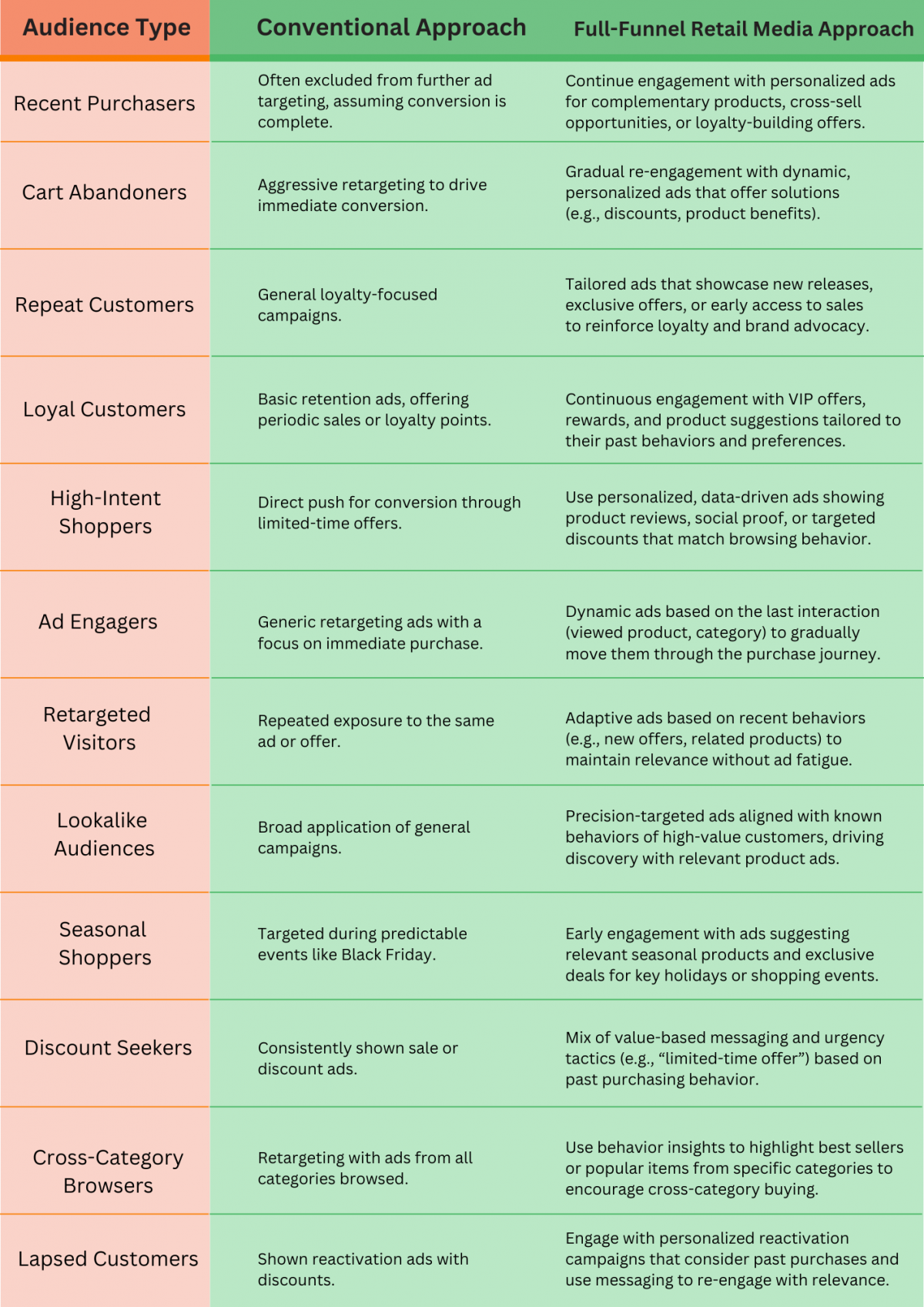
–
4. Five Ways to Fully Optimize Retail Media Performance Measurement
Achieving success with a full-funnel retail media strategy requires more than simply optimizing for specific metrics. A true full-funnel approach demands a measurement system that captures the entire consumer journey—from initial brand awareness to post-purchase loyalty building—without overlooking any stage.
Here are five key steps marketing teams should take to recalibrate retail media measurement methods, making strategies more comprehensive and effective. These principles will help brands create a tailored framework that not only aligns with business objectives but also drives long-term, sustainable growth.
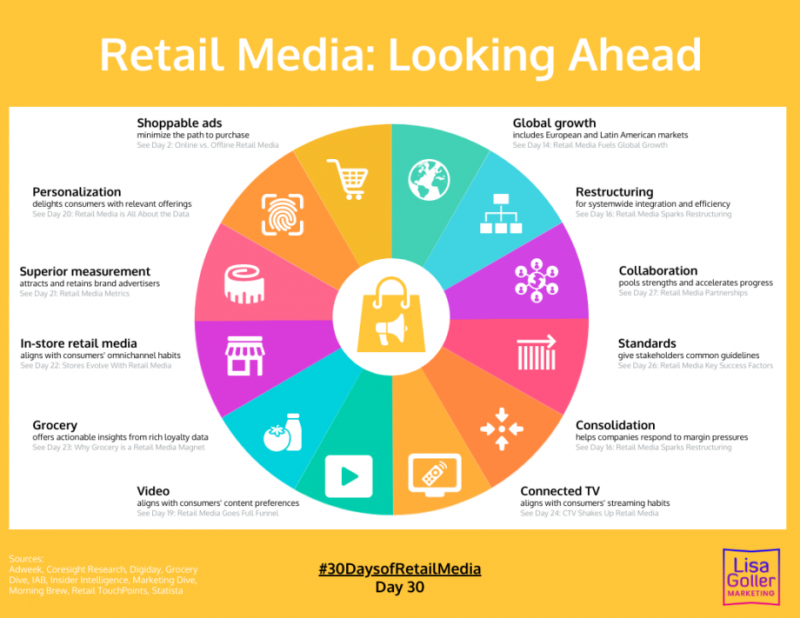
Reference: Lisa Goller Marketing
Step 1 – No one-size-fits-all formula: create a custom solution for your brand
It’s a common misconception that a universal method can apply to every brand’s full-funnel retail media strategy. In reality, each brand needs to design its own measurement approach tailored to its product mix, market positioning, and customer base. It’s not just about choosing the right tools—it’s about building a strategy that aligns with business objectives and adapts as needs evolve.
Successful full-funnel measurement requires balancing granular data and holistic behavioral data. For instance, granular data (such as ad performance or insights on specific customer segments) is crucial for campaign optimization. However, this data must be paired with broader behavioral metrics (like brand awareness growth or overall campaign ROI) to achieve both short-term tactical goals and long-term strategic objectives.
Abandon standardized, one-size-fits-all solutions in favor of a flexible, scalable measurement framework. This approach better equips brands to navigate future challenges.
Recommendations:
- Understand your brand’s unique needs and design a tailored measurement strategy.
- Focus on both granular data (e.g., ad performance) and overall data (e.g., brand lift) for a comprehensive perspective.
- Partner with technology providers that offer flexible and customizable solutions.
–
Step 2 – Incrementality: the gold standard for full-funnel retail media measurement
In retail media performance measurement, incrementality has become the gold standard due to the limited transparency of consumer behavior on retailer platforms. Traditional measurement methods often fall short in this area, whereas incrementality testing enables marketers to determine the actual additional sales value generated by media activities within these closed environments.
Retail media presents unique challenges—many ad impressions go unnoticed, and a significant portion of conversions occur naturally without being influenced by ads or campaigns. The purpose of incrementality testing is to distinguish the campaigns that truly drive additional sales, clearly revealing the actual impact of ad spend on outcomes. The key questions are: How many conversions would have occurred naturally? How many were genuinely incremental? This becomes especially challenging when measuring view-through exposure versus click-through attribution, particularly for ads close to the point of sale (e.g., product pages or branded search terms).
Most retailers don’t provide sufficient tools for testing the incrementality of on-site ads, further complicating measurement.
Another often overlooked aspect is quantifying the offline impact of on-site ads. Incrementality not only demonstrates how retail media influences hidden consumer behaviors but also strengthens measurement strategies by moving beyond cookie-based attribution. For senior decision-makers, incrementality remains a critical metric for assessing retail media return on investment (ROI).
Recommendations:
- Use incrementality testing to evaluate the real impact of retail media campaigns.
- Analyze each campaign’s specific contribution to sales to avoid over-attribution in closed retail environments.
- Leverage these insights to optimize retail media strategies and adjust budget allocations effectively.
–
Step 3 – Integrating disparate data: building a comprehensive and sustainable data framework
One of the biggest challenges in measuring retail media effectiveness is the fragmentation of data. Campaign data, retailer backend data, first-party data, and sales analysis data are often siloed and disconnected. To fully understand the benefits of a full-funnel retail media strategy, these disparate data sources must be integrated into a unified framework.
Combining fragmented data not only provides a complete perspective but also makes your measurement strategy more adaptable to future challenges. With stricter data privacy regulations and the constant emergence of new retail media technologies, brands need a flexible measurement system to address these shifts. By effectively integrating new data sources, measurement becomes more precise and can remain stable and sustainable over the long term.
Recommendations:
- Integrate retailer backend data, first-party data, and campaign data to establish a unified data view.
- Build a flexible data system capable of adapting to changes in data sources and privacy regulations.
- Ensure your data infrastructure is robust enough to accommodate the growth of new technologies and market demands.
–
Step 4 – Set stage-specific metrics: accurately measure success at every stage
In a full-funnel retail media strategy, brands must avoid using a single measurement standard across all stages, as each stage serves a different purpose. For instance, applying the same metrics to top-of-funnel (TOFU) brand awareness campaigns and bottom-of-funnel (BOFU) conversion campaigns makes it difficult to evaluate the effectiveness of ad content, audience targeting, and overall performance, ultimately hindering optimization. Each funnel stage requires unique metrics tailored to its role and objectives within the consumer journey.
At the top of the funnel (TOFU), success metrics typically include reach, brand awareness, and engagement rates. In the middle of the funnel (MOFU), the focus shifts to consumer consideration and intent, with metrics like add-to-cart rates or time spent on product pages. Finally, at the bottom of the funnel (BOFU), the emphasis is on conversion-related metrics, such as ROAS (return on ad spend), cost per conversion, and overall revenue impact.
Setting appropriate metrics for each stage ensures more accurate and fair evaluation of advertising and marketing efforts, enabling improved performance throughout the consumer journey.
Recommendations:
- Select metrics aligned with each funnel stage: TOFU (brand awareness), MOFU (product consideration), BOFU (conversion).
- Define clear and reasonable goals for each campaign, aligned with its respective funnel stage.
- Regularly review and optimize funnel performance, adjusting strategies based on the metrics for each stage.
–
Step 5 – Pacing and Balance: Continuous Testing vs. Campaign-Level Evaluation
To measure the effectiveness of a full-funnel advertising strategy, brands must strike a balance between ongoing optimization and in-depth post-campaign evaluation. Skilled marketers combine real-time testing and strategy adjustments to enhance active campaigns while using campaign-level assessments to refine strategies over time. Both approaches are equally important for achieving short-term flexibility and long-term success.
Continuous testing helps brands make real-time adjustments to creative content, target audiences, or bidding strategies, maximizing the immediate performance of campaigns. Meanwhile, campaign-level evaluation takes a broader perspective, analyzing overall performance to generate insights that improve future strategies.
By balancing these two methods, brands can maintain agility in the short term while continually refining their long-term strategies to ensure sustainable growth.
Recommendations:
- Adopt a real-time “test and learn” approach to optimize campaign performance continuously.
- Conduct in-depth evaluations after campaigns conclude to uncover deeper insights for long-term strategies.
- Balance ongoing testing with strategic campaign evaluations to achieve both short-term results and long-term growth.
–
Keeping Pace with Retail Media Evolution
The retail media landscape is constantly changing. This article provides a comprehensive Full-Funnel Retail Media Strategy, but it’s crucial for every brand and advertiser to understand that this is not a fixed solution. Success in the retail industry requires continuous improvement and the flexibility to adapt to change. At the core of this strategy is flexibility, enabling you to adjust plans based on real-time data, shifts in consumer behavior, and changes in the digital environment.
Full-funnel retail media redefines our understanding of each funnel stage, but its greatest value lies in its ability to continuously adapt to the evolving needs and behaviors of consumers at every stage. With a wealth of marketing and advertising tools at your disposal, this strategy empowers you to respond effectively.
As the retail industry evolves with new platforms, technologies, and consumer trends, your retail media strategy must evolve with it. Sustainable success depends on ongoing iteration, using continuous optimization to tackle new challenges and seize emerging opportunities.
